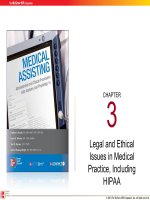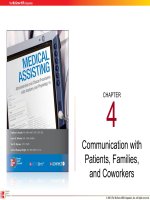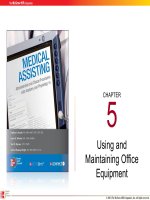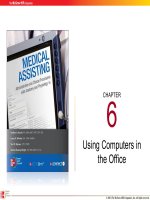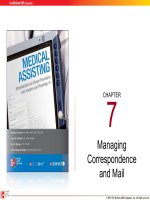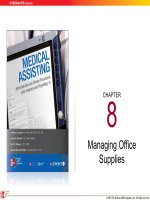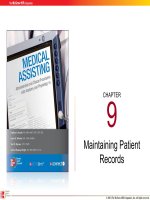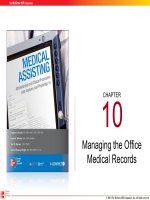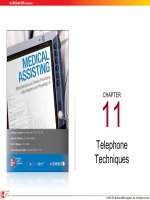Lecture Medical assisting: Administrative and clinical procedures with anatomy and physiology (4e) – Chapter 29
Bạn đang xem bản rút gọn của tài liệu. Xem và tải ngay bản đầy đủ của tài liệu tại đây (779.19 KB, 57 trang )
CHAPTER
29
The Digestive
System
© 2011 T he McGraw -Hill Com panie s, Inc. A ll rights reserv ed.
29-2
Learning Outcomes
29.1 List the functions of the digestive system.
29.2 Trace the pathway of food through the
alimentary canal.
29.3 Describe the structure and functions of the
mouth, teeth, tongue, and salivary glands.
29.4 Describe the structure and function of the
pharynx.
© 2011 T he McGraw -Hill Com panie s, Inc. A ll rights reserv ed.
29-3
Learning Outcomes (cont.)
29.5 Describe the swallowing process.
29.6 Describe the structure of the esophagus and
tell how it propels food into the stomach.
29.7 Describe the structure and functions of the
stomach.
29.8 List the substances secreted by the stomach
and give their functions.
© 2011 T he McGraw -Hill Com panie s, Inc. A ll rights reserv ed.
29-4
Learning Outcomes (cont.)
29.9 Describe the structure and functions of the
small intestine.
29.10 List the substances secreted by the small
intestine and describe the importance of
each.
29.11 Describe the structure and functions of the
large intestine, including the anal canal and
rectum.
29.12 Explain the structures and functions of the
liver, gallbladder, and pancreas.
© 2011 T he McGraw -Hill Com panie s, Inc. A ll rights reserv ed.
29-5
Learning Outcomes (cont.)
29.13 List the substances released by the liver,
gallbladder, and pancreas into the small
intestine and give the function of each
secretion.
29.14 Tell what types of nutrients are absorbed by
the digestive system and where they are
absorbed.
29.15 Describe the causes, signs and symptoms,
and treatments of various diseases and
disorders of the digestive system.
© 2011 T he McGraw -Hill Com panie s, Inc. A ll rights reserv ed.
29-6
Introduction
• Digestion
– Mechanical and chemical
breakdown of foods into
forms that body cells can
absorb
– The organs of the digestive
system carry out digestion
• Two categories
– Alimentary canal organs
– Accessory organs
© 2011 T he McGraw -Hill Com panie s, Inc. A ll rights reserv ed.
29-7
Alimentary
Canal
•
Wall of alimentary canal
– Mucosa
•
•
•
Innermost layer; epithelial tissue
Secretes enzymes and mucus into lumen
Absorbs nutrients
– Submucosa
•
•
Inferior to mucosa; loose connective tissue, blood
vessels, glands, and nerves
Blood vessels carry away absorbed nutrients
– Muscular layer
•
•
Just outside submucosa; layers of smooth muscle
Contracts to move materials through the canal
© 2011 T he McGraw -Hill Com panie s, Inc. A ll rights reserv ed.
29-8
Alimentary Canal
(cont.)
– Serosa
•
Double-walled outermost layer: peritoneum
– Visceral peritoneum
»
»
Innermost wall of serosa
Secretes serous fluid to keep outside of canal moist
– Parietal peritoneum
»
•
Abdominal lining
Movements
– Churning – mixes substances in the canal
– Peristalsis – propels substances through
the tract
© 2011 T he McGraw -Hill Com panie s, Inc. A ll rights reserv ed.
29-9
Apply Your Knowledge
What are the layers of the wall of the alimentary canal and
what do they do?
ANSWER: The layers are:
Mucosa: innermost layer; secretes enzymes and mucus into the canal and
absorbs nutrients
Submucosa: inferior to the mucosa; carries away absorbed nutrients
Muscular layer: just outside the submucosa; contracts to move materials
through the canal
Serosa: double-walled outer layer; secretes serous fluid to keep outside of
canal moist
Bravo
© 2011 T he McGraw -Hill Com panie s, Inc. A ll rights reserv ed.
29-10
The Mouth
• Buccal cavity
• Mechanical digestion
– Takes in food and
reduces its size by
chewing
• Starts chemical
digestion
– Saliva contains the
enzyme amylase, which
breaks down
carbohydrates
© 2011 T he McGraw -Hill Com panie s, Inc. A ll rights reserv ed.
29-11
The Mouth (cont.)
• Cheeks hold food in mouth
• Lips – sensory nerve fibers that judge
temperature of food
• Tongue
– Skeletal muscles covered by mucous membrane
– Lingual frenulum – holds tongue to floor of mouth
– Mixes food, holds food between teeth, contains taste
buds
– Lingual tonsils – lymphatic tissue destroys bacteria
and viruses on back of tongue
© 2011 T he McGraw -Hill Com panie s, Inc. A ll rights reserv ed.
29-12
The Mouth (cont.)
• Palate
– Roof of mouth
– Separates oral cavity from nasal cavity
– Uvula – portion of soft palate that hangs
down in throat
• Lymph tissue
– Palatine tonsils (oropharynx)
– Pharyngeal tonsils – adenoids
(nasopharynx)
© 2011 T he McGraw -Hill Com panie s, Inc. A ll rights reserv ed.
29-13
The Mouth (cont.)
• Teeth – decrease
size of food
particles
– Incisors – bite off
food pieces
– Cuspids – tear
tough food
– Bicuspids and
molars – grind
food
• Salivary glands
– Cells
• Serous
• Mucous
– Glands
• Parotid
• Submandibular
• Sublingual
© 2011 T he McGraw -Hill Com panie s, Inc. A ll rights reserv ed.
29-14
Apply Your Knowledge
Matching:
ANSWER:
B Buccal cavity
___
A. Saliva
D Roof of mouth
___
B. Mouth
E Grind food
___
C. Bolus
F Adenoids
___
D. Palate
A Water, enzymes, and mucus
___
E. Bicuspids
B Mass of food mixed with saliva and mucus
___
F. Pharyngeal
gland
© 2011 T he McGraw -Hill Com panie s, Inc. A ll rights reserv ed.
29-15
Pharynx
• Throat
• Functions
– Connects nasal
cavity with oral
cavity for breathing
– Pushes food into
esophagus
• Divisions
– Nasopharynx
• Behind nasal cavity
– Oropharynx
• Behind oral cavity
– Laryngopharynx
• Behind larynx
• Continues as
esophagus
© 2011 T he McGraw -Hill Com panie s, Inc. A ll rights reserv ed.
29-16
Pharynx (cont.)
•
Swallowing –
automatic process
1.
Soft palate rises, uvula
covers opening
between nasal and oral
cavity
2.
Epiglottis covers larynx,
keeping food out of it
3.
Tongue presses against
roof of mouth, forcing
food into oropharynx
© 2011 T he McGraw -Hill Com panie s, Inc. A ll rights reserv ed.
29-17
Pharynx (cont.)
Muscles in pharynx
contract, moving food
toward esophagus
Esophagus opens
Food is pushed into
esophagus by muscles of
pharynx
© 2011 T he McGraw -Hill Com panie s, Inc. A ll rights reserv ed.
29-18
The Esophagus
• Muscular tube connecting pharynx to stomach
– Esophageal hiatus – hole in diaphragm
through which esophagus passes
• Cardiac sphincter
– Circular band of muscle at the opening
of the stomach
– controls movement of food into stomach
© 2011 T he McGraw -Hill Com panie s, Inc. A ll rights reserv ed.
29-19
Apply Your Knowledge
Matching:
ANSWER:
E Connects nasal cavity with oral cavity
___
A. Cardiac sphincter
D Covers the opening of larynx
___
B. Esophageal hiatus
B Hole in diaphragm
___
C. Sphincter
A Controls movement of food into stomach
___
D. Epiglottis
C Circular bands of muscle
___
E. Pharynx
© 2011 T he McGraw -Hill Com panie s, Inc. A ll rights reserv ed.
29-20
The Stomach
• Below the diaphragm
in the upper left
quadrant of the
abdominal cavity
• Functions
– Receive food from
esophagus
– Mix bolus with gastric
juice
– Start protein digestion
– Move food into small
intestine
• Sections
–
–
–
–
Cardiac region
Fundus
Body
Pylorus
• Pyloric sphincter
– Controls movement of
substances into small
intestine
Stomach
© 2011 T he McGraw -Hill Com panie s, Inc. A ll rights reserv ed.
29-21
The Stomach (cont.)
• Lining of stomach
– Rugae – folds of the inner lining
– Gastric glands
• Mucous cells – secrete mucus to protect the lining
• Chief cells – secrete pepsinogen pepsin,
which digests protein
• Parietal cells
– Hydrochloric acid needed to convert pepsinogen to pepsin
– Intrinsic factor needed for vitamin B12 absorption
Stomach
© 2011 T he McGraw -Hill Com panie s, Inc. A ll rights reserv ed.
29-23
The Stomach (cont.)
• Gastric glands stimulated by
– Parasympathetic nervous system
– Gastrin (hormone)
• Cholesystokinin (hormone) secreted by the small
intestine inhibits gastric glands
• Stomach absorbs alcohol, water, and some fatsoluble drugs
• Chyme – mixture of food and gastric juices
© 2011 T he McGraw -Hill Com panie s, Inc. A ll rights reserv ed.
29-24
Apply Your Knowledge
What are the functions of the stomach?
ANSWER: The stomach’s functions are to receive
the bolus of food, mix it with gastric juice, start
protein digestion, and move food into the small
intestine. It also absorbs alcohol, water, and some
drugs.
Right Answer!
© 2011 T he McGraw -Hill Com panie s, Inc. A ll rights reserv ed.
29-25
The Small Intestine
• Tubular organ
extending from the
stomach to the large
intestine
• Functions
– Digestion
– Absorption of nutrients
• Duodenum
– C-shaped
– Short
• Jejunum
– Coiled
– Majority of small
intestine
Small
Intestine
© 2011 T he McGraw -Hill Com panie s, Inc. A ll rights reserv ed.
29-26
The Small Intestine (cont.)
• Ileum – attached to large intestine
• Mesentery
– Fan-like tissue that holds jejunum and
ileum in the abdominal cavity
– Attaches to the posterior wall of the
abdomen
• Ileocecal sphincter
– Controls movement of chyme from the
Small
ileum to the cecum of the large intestine
Intestine
© 2011 T he McGraw -Hill Com panie s, Inc. A ll rights reserv ed.

